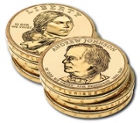

Presidential Dollar Errors versus Die Varieties
 U.S. Mint Image |
The new Presidential dollar series has gotten off to a well publicized, if not messy start. With all the Faceless and Godless dollars being reported, the recent release seems to have generated a lot of excitement in collectors and non-collectors alike.
I'm not sure if heads should roll at the U.S. Mint at the obvious poor quality control, or if those same heads should be promoted. It's sort of reminiscent of the New Coke marketing blunder that eventually resulted in new life being given to Old Coke under the Classic Coke brand.
Errors and Die Varieties Welcomed by Collectors
The Presidential dollar errors seem to have gotten the new dollars off to a great start among collectors, breathing life into the series that reminds you of the excitement when the state quarters program first started. As for being accepted in place of the dollar bill, let's just say that I have yet to receive one of these dollar coins in change.
But with all the news about the discovery of error coins, I have seen some collectors start to complain about the third party grading service coin registries not having separate entries for the new Godless dollars the same way they do for Extra Leaf Wisconsin state quarters. They want to know what gives. It seems a lot of new (and even seasoned) collectors don't really understand the difference between error coins and die variety coins.
Well, at a high level, the definitions are somewhat similar as both types of coins result from some abnormality that occurs from the norm during the minting of a coin. These abnormalities can occur anywhere in the following three phases of the minting process: making planchets, making dies, or striking coins.
In the case of the Extra Leaf Wisconsin state quarter, the abnormality occurred during the making of dies. The new Godless dollars had the abnormality occur during the striking of coins.
"Still they are both errors," you say. True, but there is a difference.
 U.S. Mint Image |
Error Coins
Errors that occur during the striking process are unique to each coin struck. Although the Godless dollars all look the same and appear to exist in the thousands, the error occurred to each coin individually. Not every coin passing through the process was guaranteed to be an error coin. It was something of a lottery as to which coins had errors. The same with the Faceless dollar. The last I heard, this coin was still unique, being the only one found so far.
Die Varieties
Die varieties, on the other hand, are problems or design alterations that occur during the making of the die. The result is that every coin struck by the die will contain this problem or design alteration. So if 10,000 coins are struck with that die, all 10,000 coins will exhibit the problem or design alteration found on that die. Being a collector of Type 1 double eagles, I own some coins that fall into the die variety category. The $20 1853/2 overdate and the 1854 large versus small dates are just a couple of examples.
So, the reason that error coins are generally not included in registry sets is because errors are generally something unique. If a die variety is discovered, it is generally safe to assume that other examples were struck and may be out there. But in the case of the Godless dollars, this is an error that was obviously repeated thousands of times. So maybe in this case, a registry entry is warranted. I'm sure it's something that will be debated on message boards.